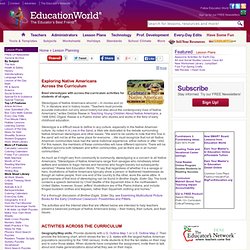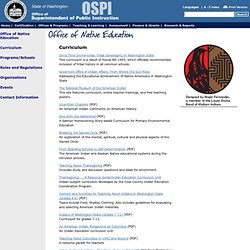

Creativity Resource for Teachers » Lesson Plans. Mimik/mimik_uploads/lesson_plans/426/Native Americans across the Curriculum.pdf. Mimik/mimik_uploads/lesson_plans/83/NOT JUST ANOTHER NATIVE AMERICAN LESSON PLAN.pdf. TribalSov: Elementary Units. Native Americans Theme Unit - Printables and Worksheets. American Indians & Native American Printables, Lessons & Activities (K-12. Native American Fiction and Nonfiction - Center for Children's Books.
Contemporary Native American Indian Children's Books: Picture Books. Contemporary Picture Books traditional stories MUSKRAT WILL BE SWIMMING by Cheryl Savageau (Abenaki-French Canadian), illustrated by Robert Hynes, featuring a Seneca traditional story retold by Joseph Bruchac (Abenaki) (Northland, 1996). When a young Native girl is called "Lake Rat," she is comforted by Grampa who both reveals how he was once called "Frog" because of his French-Indian heritage and shows how those intended insults are signs that the bullies don't appreciate the joy of the frog and wonder of the lake. Ages 4-up. THE STORY OF THE MILKY WAY, A CHEROKEE TALE by Joseph Bruchac (Abenaki) and Gayle Ross (Cherokee) with paintings by Virginia A. Stand-alones BUILDING A BRIDGE by Lisa Shook Begaye, illustrated by Libba Tracy (Northland, 1993). CIRCLE OF WONDER: A NATIVE AMERICAN CHRISTMAS STORY by N.
FOX SONG by Joseph Bruchac (Abenaki), illustrated by Paul Morin (Philomel, 1993). THE GOOD LUCK CAT by Joy Harjo (Creek), illustrated by Paul Lee (Harcourt, 2000). Exploring Native Americans Across the Curriculum. Blast stereotypes with across-the-curriculum activities for students of all ages.

Stereotypes of Native Americans abound -- in movies and on TV, in literature and in history books. "Teachers must provide accurate instruction not only about history but also about the contemporary lives of Native Americans," writes Debbie Reese in Teaching Young Children About Native Americans, a 1996 ERIC Digest. Reese is a Pueblo Indian who studies and works in the field of early childhood education. Stereotype is a difficult issue to define in any culture, especially in the Native American culture. As noted in A Line in the Sand, a Web site dedicated to the debate surrounding Native American stereotypes and other issues: "We want to be careful to note that this 'line in the sand' will not lie at the same place for everyone. ...We must recognize that not all Native American communities have had the same historical experience, either before or after 1492.
Geography/Map skills. Reading a table. Www.deq.state.or.us/lq/pubs/docs/sw/curriculum/RRPart0204.pdf. Indian Education - Curriculum. Curriculum Since Time Immemorial: Tribal Sovereignty in Washington State This curriculum is a result of House Bill 1495, which officially recommended inclusion of tribal history in all common schools.

Governors Office of Indian Affairs: From Where the Sun Rises Addressing the Educational Achievement of Native Americans in Washington State The National Museum of the American Indian This site features curriculum, online teacher trainings, and free teaching posters. Unwritten Chapters (PDF) An American Indian Comments on American History One With the Watershed (PDF) A Salmon Homecoming Story-based Curriculum for Primary Environmental Education Breaking the Sacred Circle (PDF) An exploration of the mental, spiritual, cultural and physical aspects of the Sacred Circle.
From Boarding Schools to Self Determination (PDF) The American Indian and Alaskan Native educational systems during the intrusion process. Native American Legend (A) Our Tribe. >Education Center Activity: Adapting to the Land. This activity will help students understand how people adapt to their environment. Students will consider how the environment affects how people live, identify examples of human adaptation, and appreciate human-environment interaction.
You can use an Assessment Rubric to assess students' mastery of the objectives. Paper Crayons Magazines Scissors Glue WHAT TO DOList regions in the U.S. that are very different. Draw a landform from each region. List ways we adapt to fit our surroundings. Activity Search | Reading Center | Math Center | Social Studies CenterEducation Place | Site Index You may download, print and make copies of this page for use in your classroom, provided that you include the copyright notice shown below on all such copies. Copyright © 1998 Houghton Mifflin Company. Indian-Ed.Org. American Indian Art Resource Pack. - GAMES AND TOYS.